Approach Light Signals (Semaphore to Colour Light Transition)
(Page 1 of 1)
Alternative methods of transitioning from semaphore signal territory into colour light signal territory were applied. No special arrangements are needed where the transition from one form of signal to the other is separated by around a mile or more, providing a clear gap between them. If, however, the colour light territory closely follows the semaphore territory, then the question arises as to what form the last signal at the exit from the semaphore territory should take to enable it to display the necessary 'caution' aspects on approach to the first colour light signal in the sequence.
One option is to install a motor-operated semaphore distant arm below the last semaphore stop signal. Another option is to replace the last semaphore stop signal with a colour light stop signal equipped to display the appropriate 'caution' aspects relating to the colour light signals beyond. One of the original methods commonly employed entailed the provision of a hybrid form of signal comprising a colour light distant signal mounted underneath a semaphore stop arm. The Southern Railway referred to these colour light distant signals marking the approaches to colour light territory as 'approach light' signals (not to be confused with 'approach lighting' or 'approach lit' signals). Whilst the use of these signals was not solely restricted to that company's lines, information on this page principally relates to Southern Railway practice. The semaphore signals involved may be of the lower quadrant or upper quadrant variety.
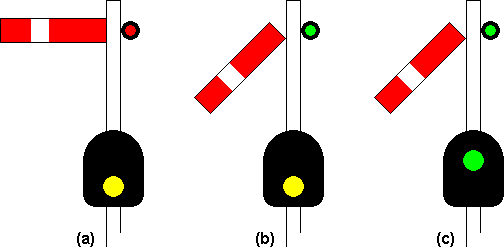
|
|
Fig. 1: Approach Light Signals.
|
Where provided, an approach light signal was mounted underneath the last semaphore signal at the exit from the semaphore signal territory, and it gave drivers an indication of the aspect displayed by the first colour light signal in the sequence ahead. The earliest approach light signals could display only single yellow ('caution') or green ('clear') aspects.
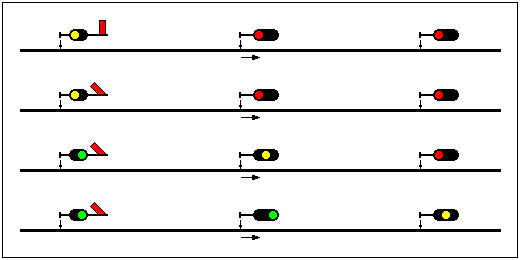
|
|
Fig. 2: Aspect Sequence.
|
Where necessary to provide sufficient braking distance approaching the first colour light stop signal, a second approach light signal was mounted below the semaphore stop signal preceding the last semaphore stop signal. This arrangement included what were referred to as inner and outer approach light signals. Originally, both were arranged to show the same aspect at the same time (single yellow or green), which avoided the undesirable display of a double yellow aspect at the outer approach light when the semaphore signal beyond may be at 'danger'.
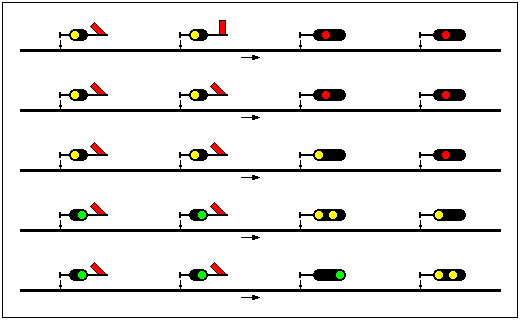
|
|
Fig. 3: Aspect Sequence - Inner and Outer Approach Light Signals.
|
|
The first approach light signals were brought into use in the south of London on the Southern Railway in March 1926. It was quickly realised that the approach lights overpowered the weaker lights of the semaphore arms below which they were mounted, increasing the risk of the signal being inadvertently passed at 'danger'. After just a few days in service, the approach lights were altered to display no aspect while the semaphore stop arm above was in the 'danger' position.
|

|
|
Fig. 4: Approach Light Signal unlit while semaphore stop arm at 'danger'.
|
|
From 1929, the practice was introduced of maintaining an outer approach light signal unlit while the semaphore stop arm above the corresponding inner approach light signal was at 'danger', even though the semaphore arm above the outer signal may be in the 'off' position. The outer approach light was therefore only illuminated when both semaphore arms were 'off' and the line was clear at least as far as the first colour light stop signal.
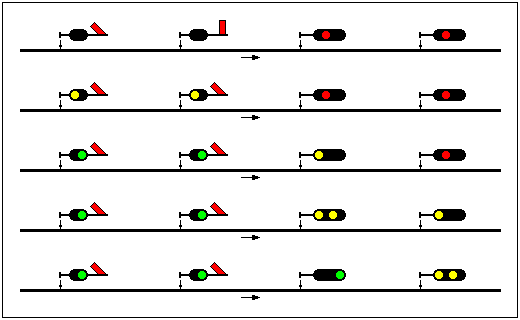
|
|
Fig. 5: Aspect Sequence - Inner and Outer Approach Light Signals.
|
|
Approach light signals capable of showing a double yellow aspect first appeared in 1929, enabling the display of a normal colour light aspect sequence leading into four-aspect signalling territory. During 1929, several existing two-lens approach lights were replaced with three-lens heads equipped with two yellow lights.
|
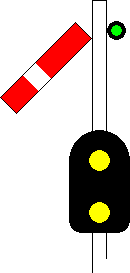
|
|
Fig. 6: Approach Light Signal displaying Double Yellow Aspect.
|
|
The introduction of approach light signals capable of displaying a double yellow aspect enabled inner and outer approach lights to display different aspects at the same time. Since the outer approach light was only illuminated when the semaphore arms above it and the inner approach light were both 'off', it was prevented from showing a double yellow aspect when the semaphore arm above it was 'off' but the one beyond was at 'danger'.
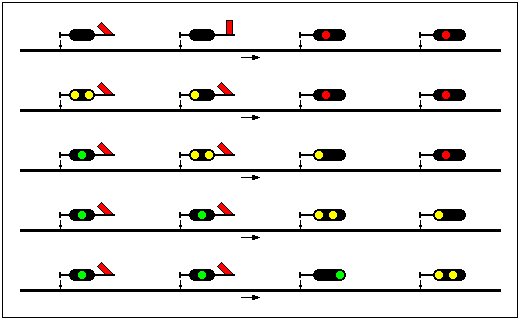
|
|
Fig. 7: Aspect Sequence - Inner and Outer Approach Light Signals.
|
From 1939, it became the practice to exhibit no light alongside a semaphore stop arm in the 'clear' position if an approach light signal was provided below. This was achieved by replacing the green spectacle in the semaphore arm with a blinder, leaving just the red spectacle in place.
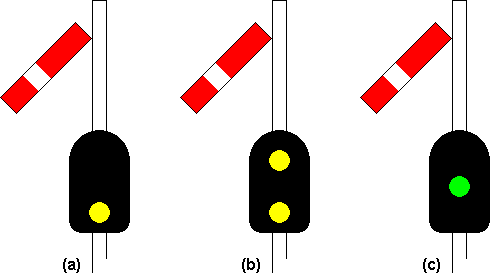
|
|
Fig. 8: No Light in Semaphore Signal when 'off'.
|
With no green light showing alongside the semaphore stop arm in the 'clear' position, the approach light signal provided the only visible 'proceed' aspect to drivers during darkness. It was therefore essential that the approach light signal always displayed an aspect when the semaphore stop arm above was 'off'. The former practice of extinguishing the outer approach light when the semaphore arm above it was 'off' but the one beyond was at 'danger' was accordingly discontinued, and the outer approach light was permitted to display a single yellow aspect in this circumstance. This last step in the evolution of approach light signals on the Southern Railway brought their signals into agreement with similar signals introduced by the LMS in March 1929 on approach to the Manchester Victoria - Manchester Exchange colour light signalling area.
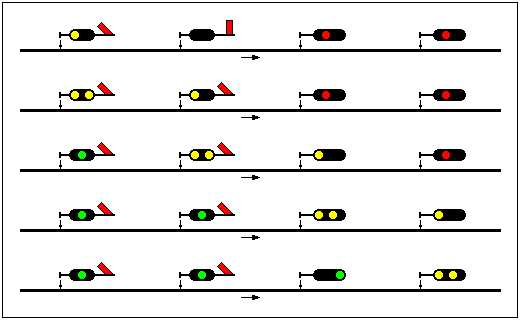
|
|
Fig. 9: Aspect Sequence - Inner and Outer Approach Light Signals.
|
The provision of approach light signals remained as a permitted option within the signalling standards until 1995. The last surviving example, at Belasis Lane (Billingham), was abolished early in 2021.
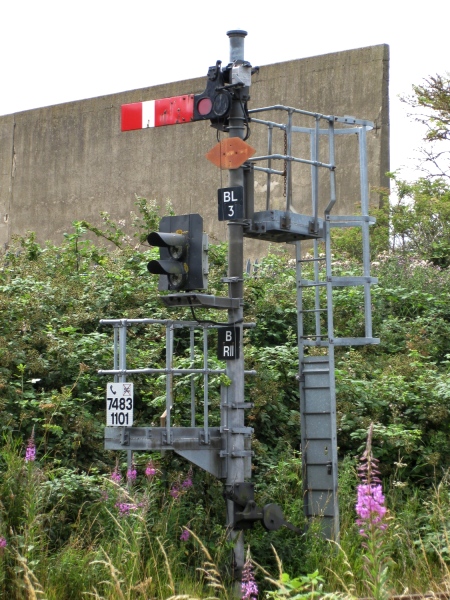
|
|
Fig. 10: Signal BL3 at Belasis Lane (Billingham).
|







